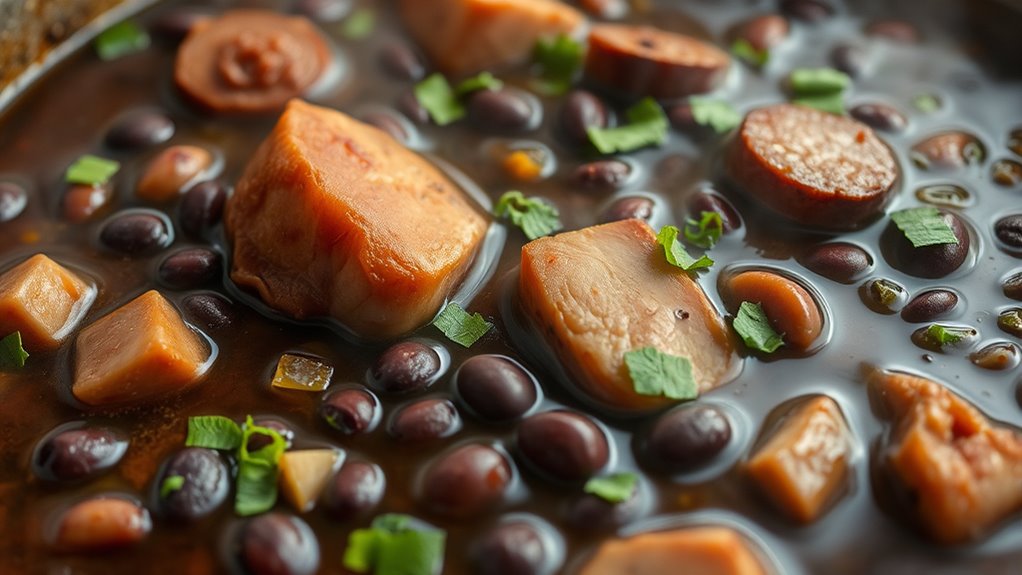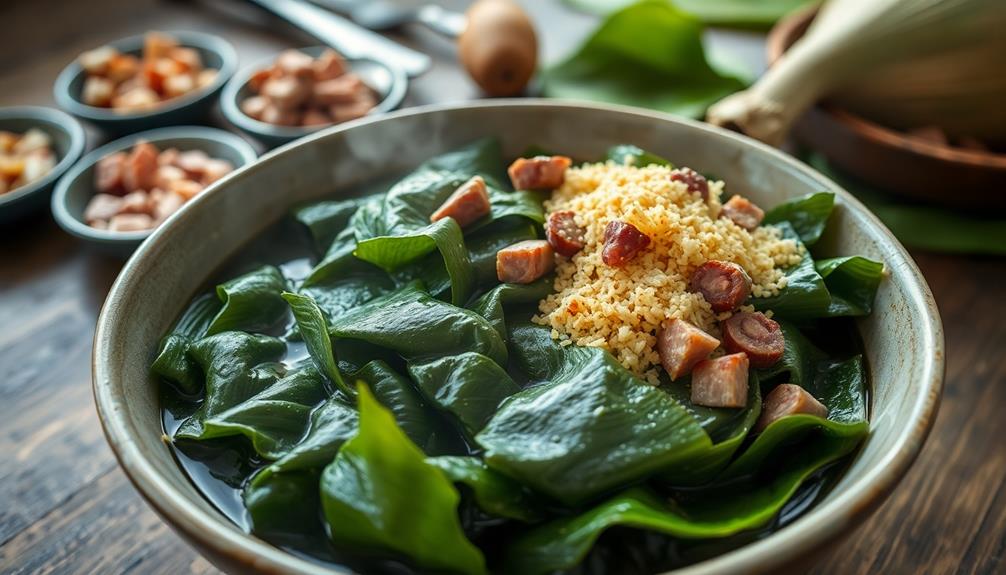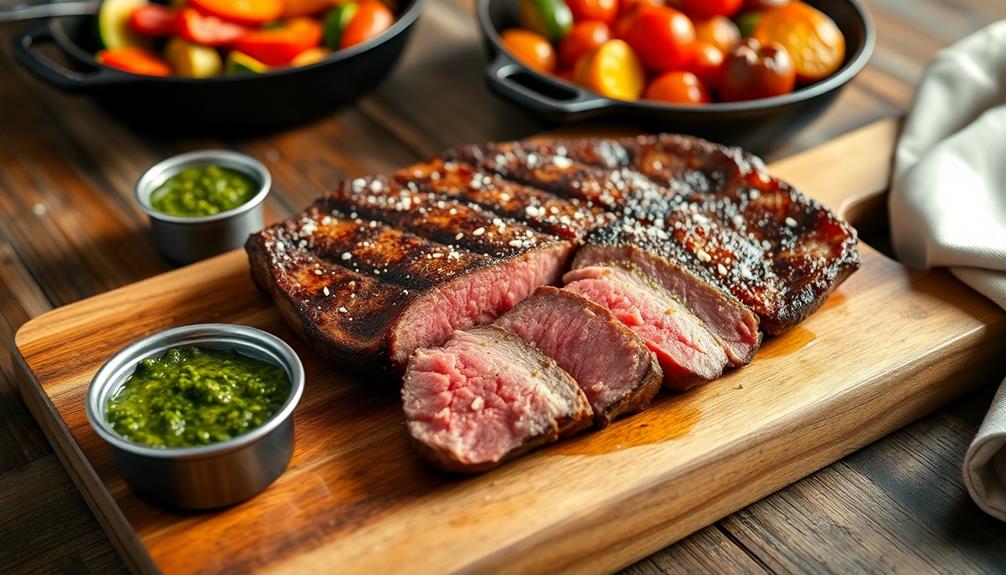When slow-cooking Brazilian feijoada, expect collagen in the meats to break down gradually over about 6 to 8 hours on low heat. This process transforms tougher cuts into tender, flavorful bites and enriches the broth with gelatin, giving it a rich, velvety texture. Patience is key, as rushing can prevent proper collagen breakdown. Continue exploring to uncover tips that help you master this slow-cooking process for authentic, melt-in-your-mouth feijoada.
Key Takeaways
- Collagen in meats begins to break down into gelatin after 4-6 hours of slow cooking.
- Optimal collagen breakdown typically occurs between 6 to 8 hours on low heat.
- Tenderness and flavor deepen as connective tissues soften and gelatin enriches the stew.
- Signs of collagen melting include meat falling apart and a thickened, glossy broth.
- Patience during the entire 6-8 hour process ensures authentic texture and complex flavors.

If you want to enjoy authentic Brazilian feijoada with minimal effort, slow-cooking is the perfect method. This approach allows the flavors to meld beautifully while ensuring the meats become irresistibly tender. When you set your slow cooker, you’re giving the collagen in the meats ample time to break down, which is key to achieving that melt-in-your-mouth texture that makes feijoada so special. Over the course of several hours, the low-and-slow process transforms tougher cuts into tender bites and develops a depth of flavor that’s hard to match with quicker methods.
Slow-cooking tenderizes meats and melds flavors for authentic Brazilian feijoada perfection.
As the cooking progresses, the collagen in the pork and beef gradually dissolves into gelatin, enriching the stew’s body and giving it a luxurious mouthfeel. This collagen breakdown is essential for both meat tenderness and flavor development. When collagen transforms into gelatin, it not only softens the meats but also releases rich, savory flavors that infuse the entire dish. You’ll notice that after about four hours, the meats start to fall apart easily, indicating that the collagen has sufficiently broken down and the flavors have intensified. Additionally, the process of collagen converting into gelatin is a natural part of slow-cooking, which enhances the overall texture and flavor profile of the stew.
Timing is vital. Typically, you’ll want to cook feijoada on low for around 6 to 8 hours, depending on the cuts you’re using and your slow cooker’s heat. Early in the process, the meats are firm, and the flavors are still developing. As hours pass, the connective tissues soften, and the meat becomes delectably tender. The simmering process allows the flavors from the smoked sausages, pork, and beef to mingle thoroughly, creating that signature complex taste. During this period, you might notice a thickening of the stew as the collagen continues to melt away, contributing to a richer, more robust broth.
Patience is particularly important because collagen breakdown occurs gradually over the course of slow cooking, not instantly. You’ll also find that patience pays off. Rushing the process might result in tougher meat and less flavor development. The beauty of slow-cooking lies in its ability to transform simple ingredients into a harmonious, flavorful masterpiece. By the time your feijoada is ready, the meats will be fall-apart tender, and the broth will be infused with deep, savory notes. So, trust the timetable, resist the temptation to speed things up, and enjoy a truly authentic, perfectly textured Brazilian feijoada that’s worth every minute of slow-coked patience. For best results, consider using quality cuts that contain connective tissue to fully benefit from collagen breakdown during slow cooking. Notably, understanding the collagen breakdown timetable can help you optimize the cooking process and achieve the ideal texture and flavor.
Frequently Asked Questions
What Are the Best Cuts of Meat for Feijoada?
When selecting meat for feijoada, focus on cuts that become tender and flavorful during slow cooking. You should go for cut recommendations like pork shoulder, ribs, and smoked sausages, which add richness and depth. These cuts contain collagen that breaks down beautifully over time, enriching the stew’s texture. Your meat selection should prioritize hearty, well-marbled cuts to guarantee a delicious, authentic feijoada experience.
How Can I Adapt Feijoada for Vegetarians?
To adapt feijoada for vegetarians, you can use hearty vegetarian substitutions like smoked tofu, tempeh, or mushrooms to mimic the texture and richness of traditional meats. Add flavor enhancements such as smoked paprika, liquid smoke, or soy sauce to boost smoky depth. Incorporate hearty beans, vegetables, and spices to create a satisfying, flavorful dish that captures the essence of classic feijoada without the meat.
What Side Dishes Complement Feijoada?
When choosing side dishes for feijoada, think of traditional accompaniments like rice, collard greens, and farofa. These balance the hearty flavors and add texture. For beverage pairings, opt for a cold caipirinha or light beer to refresh your palate. You can also serve sliced oranges or hot sauces to enhance the experience. These choices complete your meal and highlight the rich, comforting nature of feijoada.
How Do I Store Leftovers Safely?
To store leftovers safely, focus on good food safety practices and proper storage methods. You should cool the feijoada quickly, then transfer it into airtight containers. Keep the leftovers refrigerated at 40°F or below and consume within 3-4 days. If you want to save it longer, freeze it in freezer-safe containers. Always reheat leftovers thoroughly before eating to prevent foodborne illnesses.
Can I Freeze Feijoada for Later?
Did you know that properly stored, cooked feijoada can last up to 3 months in the freezer? Yes, you can freeze feijoada for later! Follow these freezing tips: cool it completely, use airtight containers, and label with dates. Adhere to storage guidelines to prevent freezer burn and maintain flavor. Freezing preserves leftovers effectively, making it easy to enjoy your delicious Brazilian stew whenever you want.
Conclusion
As you simmer your feijoada, remember it’s like nurturing a good friendship—patience brings out the best flavors. Keep an eye on the collagen breakdown timetable, and don’t rush the process. With time, those tough cuts transform into tender, flavorful bites, making every spoonful worth the wait. So, embrace the slow cooking journey, and soon you’ll enjoy a rich, hearty dish that’s as comforting as a warm hug on a chilly day.









